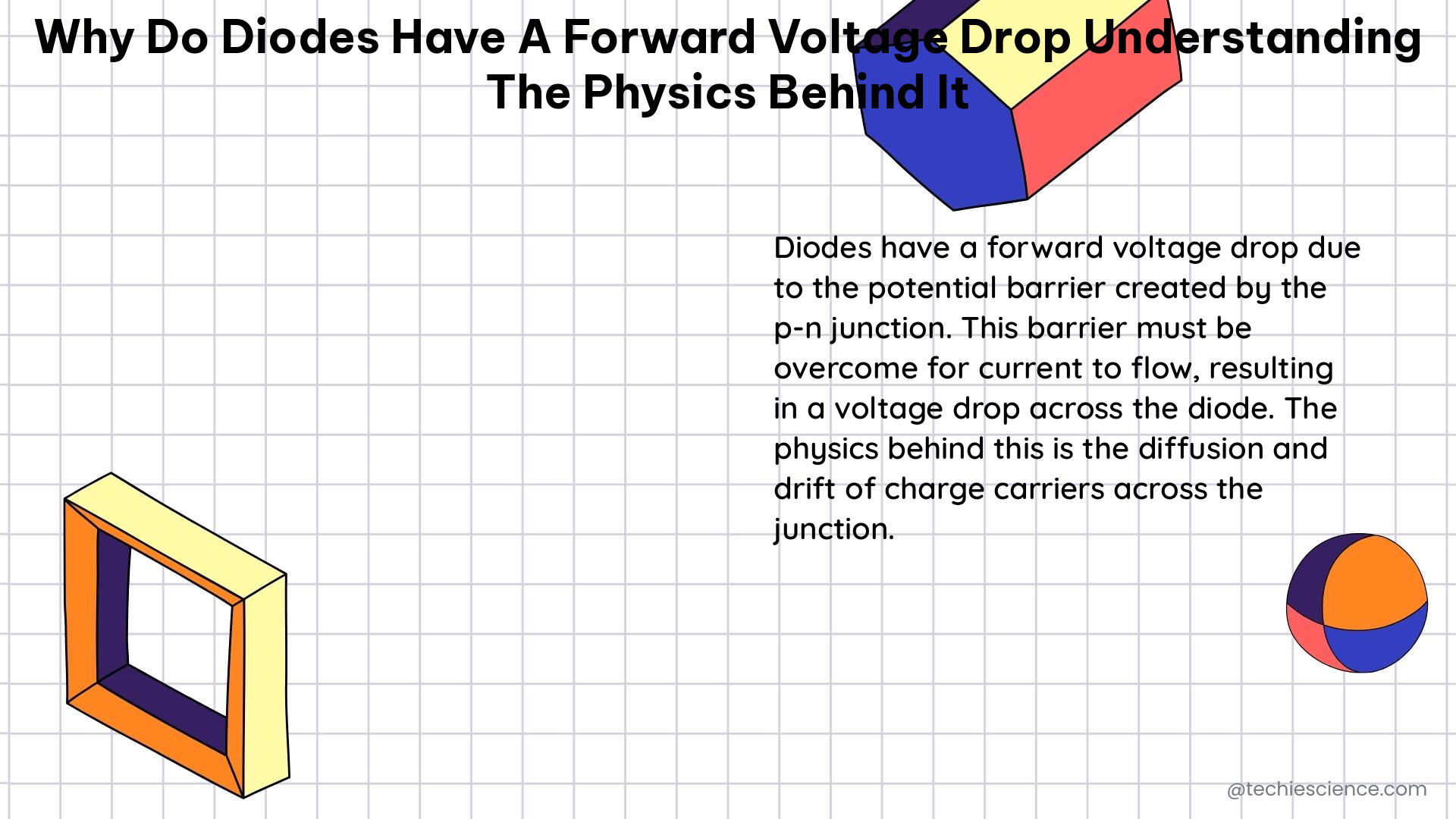The forward voltage drop in a diode is a fundamental property of its construction and operation. It is the voltage drop that occurs across a diode when it is conducting current in the forward direction, which is the direction that allows current to flow easily. The physics behind this voltage drop can be explained by the behavior of charge carriers, specifically electrons and holes, within the diode’s p-n junction.
The P-N Junction and Depletion Region
When a diode is forward biased, the positive terminal of the voltage source is connected to the p-side (anode) and the negative terminal is connected to the n-side (cathode). This causes the depletion region, which is the region around the p-n junction that is devoid of charge carriers, to shrink.
The depletion region is formed due to the diffusion of electrons from the n-side to the p-side and the diffusion of holes from the p-side to the n-side. This creates a region around the junction that is depleted of charge carriers, and an electric field is established across this region.
As the voltage is increased in the forward direction, the depletion region continues to shrink until it reaches a critical point where the electric field across the junction is strong enough to accelerate the charge carriers and allow them to overcome the potential barrier.
Potential Barrier and Charge Carrier Behavior

The potential barrier at the p-n junction is the energy required for charge carriers (electrons and holes) to cross the junction. This potential barrier is typically around 0.7 volts for silicon diodes, but it can vary depending on the specific type of diode and the materials used.
When the diode is forward biased, the potential barrier is reduced, and the charge carriers can more easily overcome it. As the voltage is increased, the potential barrier continues to decrease, and the charge carriers can flow more freely across the junction.
However, even when the diode is conducting current in the forward direction, there is still a small potential barrier that the charge carriers must overcome. This potential barrier is the primary cause of the forward voltage drop in the diode.
Factors Affecting the Forward Voltage Drop
The forward voltage drop in a diode is influenced by several factors:
-
Diode Type: Different types of diodes have different forward voltage drops. For example, a Schottky diode, which uses a metal-semiconductor junction instead of a p-n junction, has a lower forward voltage drop of around 0.3 to 0.4 volts.
-
Current Flow: The forward voltage drop is also dependent on the current flowing through the diode. As the current increases, the forward voltage drop tends to decrease slightly due to the increased number of charge carriers and the reduced potential barrier.
-
Temperature: The forward voltage drop is also dependent on the temperature, with higher temperatures causing an increase in the forward voltage drop. This is due to the increased thermal agitation of the charge carriers, which makes it more difficult for them to overcome the potential barrier.
Measuring the Forward Voltage Drop
The forward voltage drop can be measured using a multimeter or an oscilloscope. To measure the forward voltage drop using a multimeter, you can apply a voltage to the diode and measure the voltage drop across it. The forward voltage drop can also be measured by looking at the voltage waveform across the diode using an oscilloscope.
When measuring the forward voltage drop, it’s important to consider the specific conditions, such as the current flowing through the diode and the temperature, as these factors can affect the measured value.
Practical Implications of the Forward Voltage Drop
The forward voltage drop in a diode is an important consideration in many electronic circuits and applications. For example, in power supply circuits, the forward voltage drop of the rectifier diodes can affect the efficiency and output voltage of the power supply. In LED circuits, the forward voltage drop of the LED can determine the required voltage and current for proper operation.
Understanding the physics behind the forward voltage drop in diodes is crucial for designing and analyzing electronic circuits, as it allows engineers to predict and account for the voltage drop in their designs. By considering the factors that affect the forward voltage drop, such as diode type, current, and temperature, engineers can optimize their circuit designs and ensure reliable and efficient operation.
Conclusion
In summary, the forward voltage drop in a diode is a fundamental property of its operation and is caused by the behavior of charge carriers within the p-n junction. The forward voltage drop is typically around 0.7 volts for silicon diodes, but it can vary depending on the specific type of diode and the current flowing through it. The forward voltage drop is also dependent on the temperature and can be measured using a multimeter or an oscilloscope.
Understanding the physics behind the forward voltage drop in diodes is crucial for designing and analyzing electronic circuits, as it allows engineers to predict and account for the voltage drop in their designs. By considering the factors that affect the forward voltage drop, engineers can optimize their circuit designs and ensure reliable and efficient operation.
References
- Why is there a voltage drop across diodes? Why is it around 0.7V?
- Forward voltage of a diode
- Diode – Forward voltage drop

The lambdageeks.com Core SME Team is a group of experienced subject matter experts from diverse scientific and technical fields including Physics, Chemistry, Technology,Electronics & Electrical Engineering, Automotive, Mechanical Engineering. Our team collaborates to create high-quality, well-researched articles on a wide range of science and technology topics for the lambdageeks.com website.
All Our Senior SME are having more than 7 Years of experience in the respective fields . They are either Working Industry Professionals or assocaited With different Universities. Refer Our Authors Page to get to know About our Core SMEs.